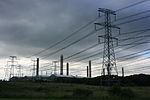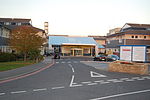Lynemouth power station

Lynemouth Power Station is a biomass power plant which provides electricity for the UK National Grid. Until March 2012, it was the main source of electricity for the nearby Alcan Lynemouth Aluminium Smelter. It is located on the coast of Northumberland, north east of the town of Ashington in north east England. The station has stood as a landmark on the Northumberland coast since it opened in 1972, and had been privately owned by aluminium company Rio Tinto Alcan throughout its operation until December 2013, when RWE npower took over. In January 2016 it was acquired by Energetický a průmyslový holding.The station is one of the most recently built coal-fired power stations in the United Kingdom, but with a generating capacity of only 420 megawatts (MW), was one of the smallest.In 2011, it was announced that the power station may be converted to burn biomass only, in a bid to avoid government legislation. In January 2016 the station was purchased by Energetický a průmyslový holding (EPH). The station converted to biomass in 2018, ending its use of coal. Two separate wind farm plants currently have permission to be built near the station, one for a 13 turbine wind farm near the smelter and another three turbine wind farm to the north of the station. In 2009, Alcan announced that they hope to fit the station with carbon capture and storage technology.
Excerpt from the Wikipedia article Lynemouth power station (License: CC BY-SA 3.0, Authors, Images).Lynemouth power station
England Coastal Path,
Geographical coordinates (GPS) Address Nearby Places Show on map
Geographical coordinates (GPS)
| Latitude | Longitude |
|---|---|
| N 55.204166666667 ° | E -1.5208333333333 ° |
Address
England Coastal Path
NE63 9NW , Newbiggin by the Sea
England, United Kingdom
Open on Google Maps









